Product Snapshot
Ripening Dates
Apples
- Yellow Transparent Apple – late July to early August
- Wolf River Apple – Early to mid-August
- Summer Rambo Apple – Late August to September
- Freedom Apple – Late September
- Golden Delicious Apple – Late September to early October
- Northern Spy Apple – Mid to late October
- GoldRush Apple – Md to late October
- Nova Spy Apple – End October
- Fuji Apple – Late October to early November
Other Fruits
- Montmorency Cherry – Late June
- Kristen Sweet Cherry – Mid July
- Veteran Peach – Early August
- Contender Peach – August
- Raritan Rose White Peach – Early August
- Harrow Sweet Pear – Mid September
- Seckel Pear – Mid September
- Shenandoah Pear – Mid September
- Kenmore Plum – End August Beginning September
- Bluebyrd – Plum – Beginning September
- Long John Plum – September
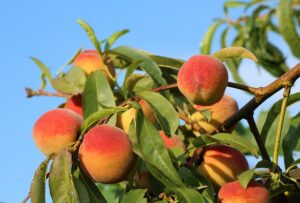
Complementary Pollinators
Apples
These apples are Late and Mid-Season Bloomers and will pollinate each other.
- Northern Spy
- Nova Spy
- Crimson Crisp
- Wolf River
- GoldRush
- Fuji
- Golden Delicious
- Summer Rambo
These apples are Early and Mid-Season Bloomers and will pollinate each other.
- Freedom
- Yellow Transparent
- Summer Rambo
- Fuji
- Golden Delicious
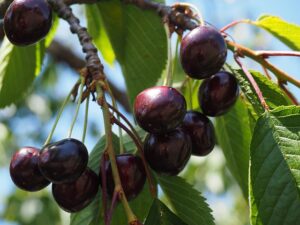
Pears
All three of the pear varieties that we are offering will pollinate each other.
Peaches
All three of the peach varieties that we are offering are self-pollinating but will benefit from pollination from any of the other peaches we are offering.
Plums
Cherries
All three of the plum varieties that we are offering a self-pollinating but will benefit from pollination from any of the other peaches we are offering.
Montmorency is self pollinating
Kristen needs a pollinator and can be pollinated by Montmorency even though it is a sour cherry.
Mature Tree Size
18 Foot to 20 Foot - Semi Dwarf
- Nova Spy Apple
- Northern Spy Apple
- GoldRush Apple
- Freedom Apple
- Wolf River Apple
- Seckel Pear
- Shenandoah Pear
- Long John Plum
- Harrow Sweet Pear (20′ to 30′ – Standard Size Pear)

15 Foot to 18 Foot - Short Semi-Dwarf
- GoldRush Apple
- Crimson Crisp Apple
- Yellow Transparent Apple
- Summer Rambo Apple
- Raritan Rose White Peach (15′ to 25′)
- Shenandoah Pear – (12′ to 14′)
- Bluebyrd Plum
- Kenmore NY9 Plum
- Kristen Sweet Cherry
10 Foot to 12 Foot - Dwarf
- Fuji Apple
- Golden Delicious Apple
Naturally Dwarfing Standard
- Montmorency Cherry – 15 Foot
- Contender Peach – 12 Foot to 15 Foot
- Veteran Peach – 10 Foot to 12 Foot
Cold Hardiness
Extremely Cold Hardy
- Freedom Apple
- Northern Spy Apple
- Nova Spy Apple
- GoldRush Apple
- Summer Rambo Apple
- Yellow Transparent Apple
- Wolf River Apple
- Montmorency Cherry
- Kristen Sweet Cherry
- Seckel Pear
- Harrow Sweet Pear
- Long John Plum
Cold Hardy Enough for Garrett County But Don't Plant in a Frost Pocket
- Fuji
- Crimson Crisp
- Golden Delicious
- Shenandoah Pear
- Bluebyrd Plum
- Kenmore Plum
- All Peaches
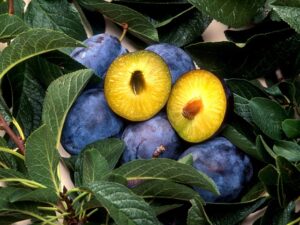
Disease Resistance
Following is a listing of the disease resistance genetics of each apple cultivar for Fire Blight, Apple Scab, Powdery Mildew, and Cedar Apple Rust. Information is from Cornell University Susceptibility Rankings. It should be noted that this list of Disease Resistance was compiled by various breeders and organizations that may have had differing results with a specific cultivar. And as is particularly the case with heirlooms, disease resistance may vary in the results depending upon whether the trial happened in the area to which the tree is naturalized.
Heirloom varieties specific to a region have built immunity to various bacteria and virus’ in that region making them less susceptible to tree diseases than newer cultivars. However, that can vary from tree to tree. So, there is no guarantee. Some heirlooms were abandoned due to issues with diseases.
All of the heirlooms we are carrying are ones known to be naturalized in our area and they have had a history of successful growth in the Garrett County and surrounding region. Some of them may be susceptible to some diseases, which is a risk often associated with the purchase of heirlooms.
All of this is basically to say that with the newer cultivars, the list is probably pretty accurate. With the heirlooms, they may, or may not, have more disease resistance than is listed.
- Northern Spy – Resistant to Fire Blight. Very old heirloom.
- Nova Spy – Resistant to Apple Scab and Powdery Mildew
- Yellow Transparent – Resistant to Apple Scab, Powdery Mildew, and Cedar Apple Rust
- GoldRush – Resistant to Apple Scab, Powdery Mildew, and Fire Blight. Do not plant near a Juniper tree.
- Golden Delicious – (Gibson Golden) – Heirloom, resistance is not consistent
- Fuji – Resistant to Powdery Mildew and Cedar Apple Rust
- Crimson Crisp – Resistant to Apple Scab, Fire Blight, Powdery Mildew
- Freedom – Resistant to Fire Blight, Apple Scab, Powdery Mildew, and Cedar Apple Rust
- Wolf River – Resistant to Fire Blight, Apple Scab, and Powder Mildew
- Summer Rambo – Very old (1500’s) heirloom, no resistance documented
- Kenmore Plum – NY 9 – Resistant to Black Knot, Brown Rot, and Leaf Spot. Also tolerant to mites and Bacterial Spot.
- Bluebyrd Plum – Resistant to Black Knot, Plum Pox Virus, and Brown Rot.
- Long John Plum – Resistant to Black Knot. This particular Long John tree can be planted in heavy clay soil due to its specialty rootstock.
- Shenandoah Pear – Resistant to Fire Blight and Superficial Scald
- Harrow Sweet Pear – Resistant to Fire Blight and Pear Scab.
- Veteran Peach – Resistant to Clasterosporia, Cytosporosis, Peach Leaf Curl, Bactrial Spot, Powdery Mildew, and Brown Rot. Veteran is known as a good choice for a disease resistant peach.
- Contender Peach – Has good disease resistance, including Bacterial Leaf Spot, Leaf Curl, and Brown Rot.
- Raritan Rose – Resistant to Bacterial Spot and Peach Leaf Curl
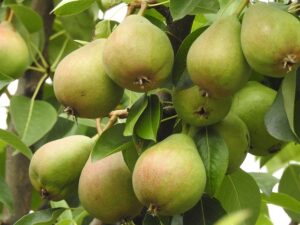
Mature Tree Support Needs
Free Standing Once Trunk Reaches 4"
This means the tree would not need support under normal conditions. If it is in an area of high wind, or other factors that could put an abnormal strain on the trunk, it may still need to be supported.
Needs Support for Life of Tree
Some trees do not put down deep root systems. Or the trunk may not be as sturdy. In this event, the tree would need supported with stakes or some other support system for the life of the tree. Additionally, all dwarf trees should have support for the life of the tree because fruit production may be heavier than the tree can support.
- Freedom Apple
- Northern Spy Apple
- Nova Spy Apple
- GoldRush Apple
- Yellow Transparent Apple
- Wolf River Apple
- Montmorency Cherry
- Kristen Sweet Cherry
- Seckel Pear
- Harrow Sweet Pear
- Long John Plum
- Crimson Crisp
- Shenandoah Pear
- Bluebyrd Plum
- Kenmore Plum
- Veteran Peach
- Contender Peach
- Raritan Rose Peach
- Fuji (Dwarf)
- Yellow Transparent (EMLA 7)
- Summer Rambo (EMLA 7)
- Golden Delicious (Although this tree will put down deep roots as opposed to surface roots like many dwarf trees, it will need support until mature, and we recommend continued support simply because as a dwarf tree, the fruit load may be too heavy for the tree. This tree will be sturdier than the typical dwarf tree.)
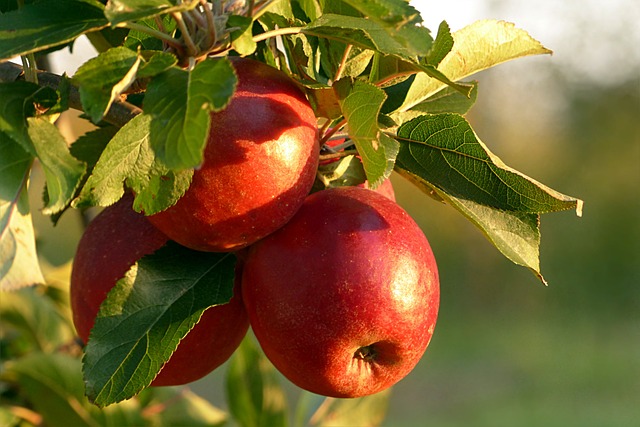
Did you know that many of the trees sold in chain stores are on EMLA 7 rootstock? It has been the standard for semi-dwarf trees within chain tree sales for a very long time. However, EMLA 7 doesn’t put down as deep of roots as many other rootstocks, and it is prone to breakage of the trunk. Therefore, even though most stores don’t tell you this, the tree should have some type of support for the life of the tree even if the trunk diameter seems like it should be sufficient to support the tree.
Whenever possible, we put our semi-dwarf trees that would be similar in size to EMLA 7 on a more expensive designer rootstock that has deeper roots and a sturdier trunk. If you are wondering if we sacrificed disease resistance and cold tolerance, the answer is “no”. Our designer rootstocks are actually even more cold hardy and have just as good of disease resistance.
With this said, we do have two trees available that are on EMLA 7 because they are heirlooms and hard to obtain. Since these were already grafted, we were unable to get them on any other rootstock. This is not a problem, but just know that you should have support in place for your tree(s) for the life of the tree(s).